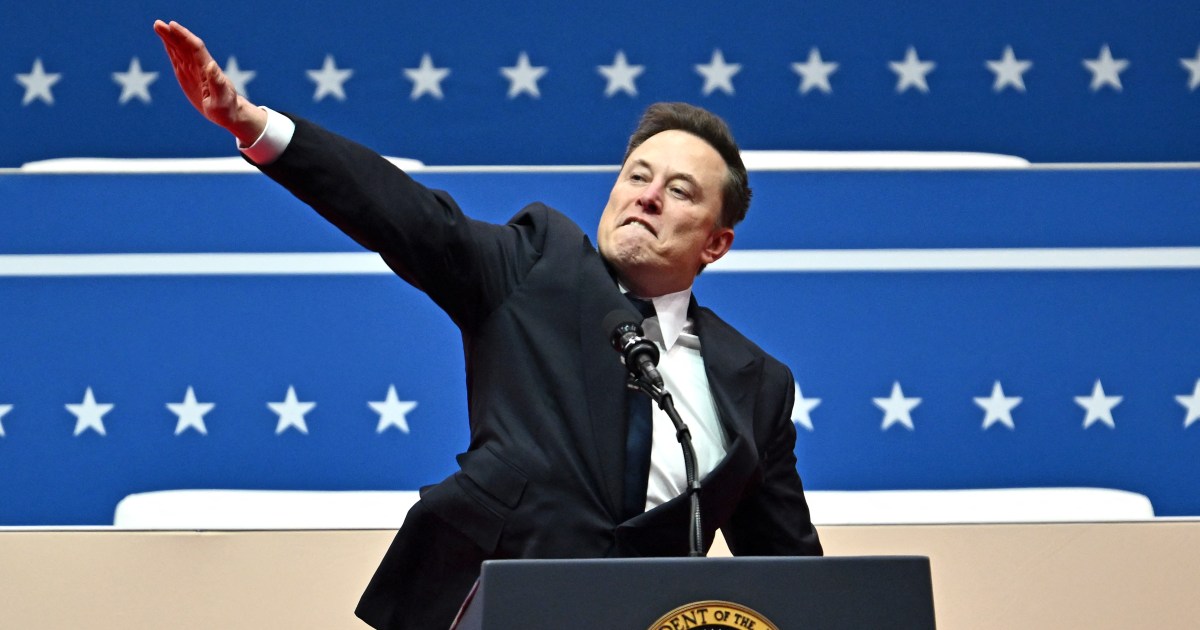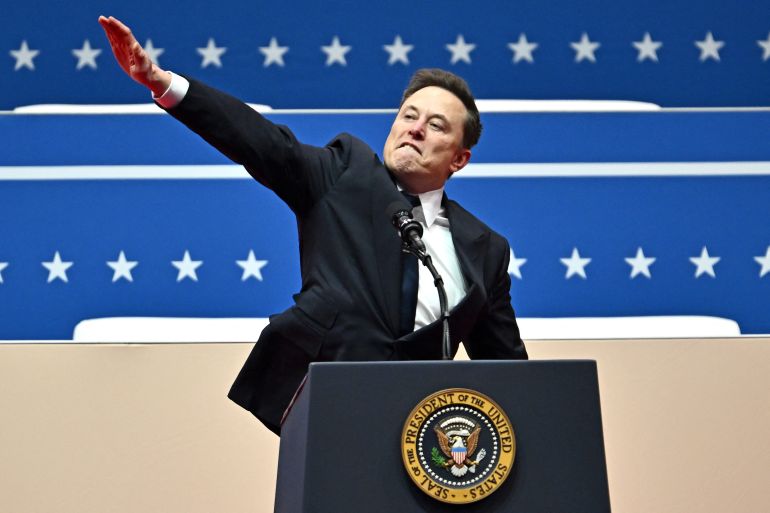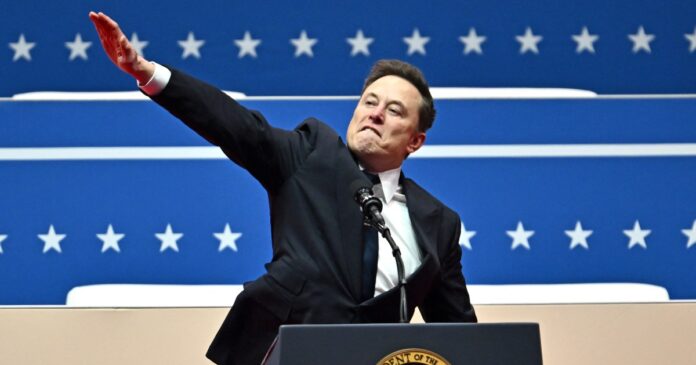## The Salute That Sparked a Storm: Did Elon Musk Just Wink to the Far Right?
Elon Musk, the billionaire entrepreneur and self-proclaimed “technoking,” has never been shy about his opinions. But his actions speak louder than words, and one particular moment from Donald Trump’s inauguration has sent shockwaves through the internet. A seemingly simple salute captured by cameras has ignited a firestorm of debate: Was it an innocuous gesture, or a veiled nod to a disturbing ideology?

The Gesture and its Immediate Backlash

During the inauguration speech of Donald Trump as the 47th US President on January 20, 2025, Elon Musk, the CEO of Tesla and SpaceX, made a hand gesture that quickly sparked controversy. Addressing a crowd of Trump supporters at the Capital One Arena in Washington, DC, Musk, who had been appointed to lead the newly formed Department of Government Efficiency in the Trump administration, extended his right arm at an upward angle with his palm down and fingers together, after slapping his hand on his chest. This gesture, reminiscent of the Nazi salute known as “Sieg Heil,” was captured on video and disseminated widely online, prompting immediate accusations of anti-Semitism and Nazi sympathies.
Social media platforms erupted with reactions, with many users condemning Musk’s gesture as a blatant display of Nazi ideology. The hashtag #MuskNaziSalute trended worldwide, accompanied by calls for Musk’s resignation from his government position. A post by the Democratic congressman Jerry Nadler from New York on X (formerly Twitter) read, “I never imagined we would see the day when what appears to be a Heil Hitler salute would be made behind the Presidential seal. This abhorrent gesture has no place in our society and belongs in the darkest chapters of human history. I urge all of my colleagues to unite in condemning this hateful gesture for what it is: antisemitism.”
The Israeli newspaper Haaretz also reported on the incident, stating that Musk appeared to have given a “‘Roman salute,’ a fascist salute most commonly associated with Nazi Germany.” Musk’s gesture was further condemned by various Jewish organizations and individuals who expressed their outrage and concern over the billionaire’s apparent endorsement of Nazi symbolism.
Interpretations and Defenses
Elon Musk, however, refuted the claims of anti-Semitism, dismissing the controversy on X as a tired tactic and stating that his critics needed “better dirty tricks.” He wrote, “The “everyone is Hitler” attack is sooo tired,” accompanied by a sleepy face emoji.
Despite Musk’s denial, the incident sparked intense debate and differing interpretations. The Anti-Defamation League (ADL), a prominent organization fighting anti-Semitism, offered a more conciliatory stance, suggesting that Musk’s gesture was likely an awkward one made in the heat of the moment, rather than a deliberate Nazi salute. “In this moment, all sides should give one another a bit of grace, perhaps even the benefit of the doubt, and take a breath,” the ADL stated on X. “This is a new beginning. Let’s hope for healing and work toward unity in the months and years ahead.”
However, this response drew criticism from other Jewish groups, who vehemently disagreed with the ADL’s assessment. Max Kaiser, executive officer of the Jewish Council of Australia, stated, “It was a clear signal to his rabid white nationalist and neo-Nazi followers that he aligns with their values. His platform ‘X’ is well known for promoting racist neo-Nazi content and he has recently endorsed the far-right Alternative for Germany (AfD) German political party. We should all be very concerned that the right-hand man of the most powerful person in the world is a Nazi. The ADL continue to disgrace themselves by defending Musk’s gesture while baselessly attacking expressions of pro-Palestinian solidarity as anti-Semitic.”
Alex Ryvchin, co-chief executive of the Executive Council of Australian Jewry, offered a different perspective, stating that Musk was likely “overcome with passion and emotion in that moment and gestured appreciatively to the crowd.”
The Bigger Picture: Musk’s Political Affiliation and Online Platform
Musk’s Role in the Trump Administration
Elon Musk’s appointment to the Department of Government Efficiency in the Trump administration raised eyebrows even before the inauguration incident. Musk, known for his outspoken views and unconventional approach to business, had previously expressed admiration for some of Trump’s policies, particularly his stance on deregulation and his focus on economic growth. However, his appointment to such a high-profile position also drew criticism from those who viewed him as unqualified for the role and concerned about his potential influence on government policy.
Content on Musk’s Platform ‘X’
The nature of content allowed on Musk’s social media platform, formerly known as Twitter, has also been a source of controversy. Since Musk acquired the company in 2022, there have been concerns about a rise in hate speech, misinformation, and extremist views on the platform. Critics argue that Musk’s relaxed content moderation policies have created a more hospitable environment for these types of harmful content, while Musk maintains that his goal is to promote “free speech absolutism” on the platform.
Social Media Algorithms and Misinformation
The incident involving Musk’s gesture also highlights the potential dangers of social media algorithms in spreading misinformation and amplifying divisive content. Algorithms designed to promote engagement often prioritize sensationalized or emotionally charged content, which can lead to the rapid dissemination of false or misleading information. In this case, the video of Musk’s gesture was quickly shared and viewed millions of times, and the accompanying commentary often lacked context or nuance, contributing to the spread of misinformation and fueling the controversy.
Navigating the Nuance: Understanding the Dangers of Misinterpretation
Importance of Critical Thinking and Avoiding Hasty Judgments
The Elon Musk incident underscores the importance of critical thinking and avoiding hasty judgments online. In the age of social media, information spreads at an unprecedented rate, and it is essential to approach online content with a healthy dose of skepticism. It is crucial to consider the source of information, look for evidence to support claims, and be aware of potential biases or agendas. Jumping to conclusions based on incomplete or misleading information can contribute to the spread of misinformation and exacerbate societal divisions.
Cultural Misunderstandings and the Need for Context
Furthermore, the incident highlights the potential for cultural misunderstandings and the need for context. Gestures that are commonplace in one culture may be offensive or have different meanings in others. Failing to consider cultural nuances can lead to misinterpretations and unintended offense. In the case of Musk’s gesture, it is important to acknowledge the historical significance of the “Sieg Heil” salute and the deep-seated trauma it evokes for many people. While Musk may have intended no harm, his gesture was undeniably reminiscent of Nazi symbolism and therefore deeply insensitive.
Responsibility of Public Figures
The incident also raises questions about the responsibility of public figures to be mindful of their actions and words. Given their platform and influence, public figures have a greater responsibility to consider the potential impact of their actions on others. Musk’s gesture, regardless of his intent, had a profound impact on many people, and it is important for him to acknowledge the harm that his actions have caused and to take steps to repair the damage.
Conclusion
The image of Elon Musk subtly raising his hand in a gesture reminiscent of the Nazi salute at Trump’s inauguration sent shockwaves through the internet. While Musk and his supporters insist it was a simple wave, the resemblance to the notorious Nazi salute sparked intense debate, forcing us to confront the power and potential pitfalls of seemingly innocuous gestures. The article explored the historical context of the salute, examined the arguments for and against Musk’s intention, and delved into the broader implications of misinterpretations and the weaponization of symbolism in the digital age.
Ultimately, the question of whether Musk’s gesture was intentional or a mere coincidence remains unanswered. What is undeniable, however, is the profound impact this incident has had on our understanding of online discourse and the dangers of hastily assigning meaning to ambiguous actions. This event serves as a stark reminder that in a world saturated with information and prone to rapid judgement, context and nuance can easily be lost. It compels us to engage in thoughtful, critical analysis rather than succumbing to knee-jerk reactions fueled by incomplete information. As we navigate the increasingly complex digital landscape, remembering this incident can help us foster a more understanding and discerning online environment.
The question isn’t just about a single gesture, but about the responsibility we all share in interpreting and communicating with each other in a world where symbolism can be weaponized and misconstrued.
